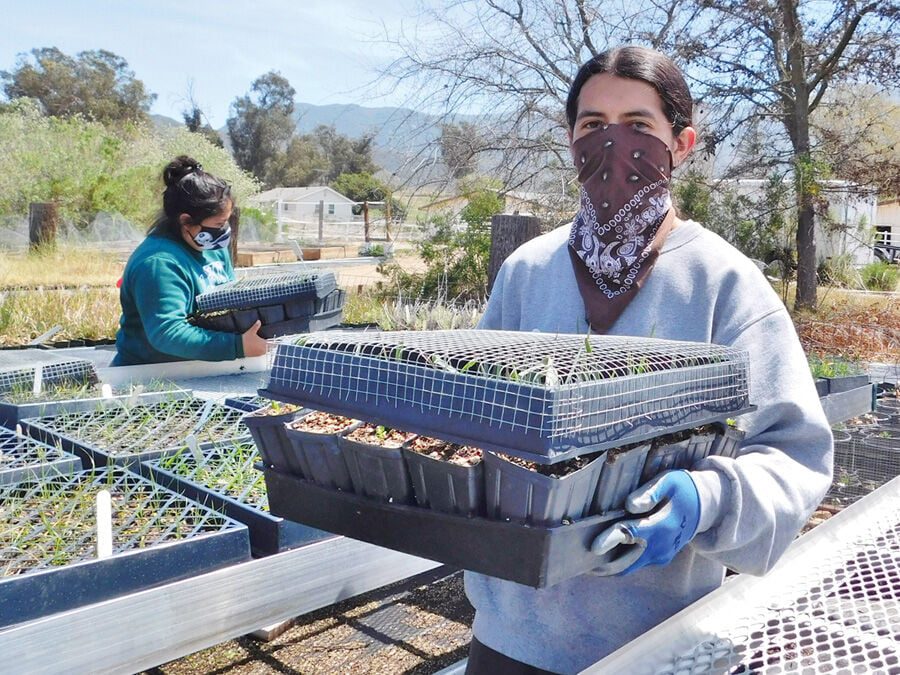The Native Plant Nursery of the Santa Monica Mountains has existed in near obscurity since it was first started 20 years ago on Santa Monica Mountain National Recreation Area (SMMNRA) National Park Service land in Newbury Park. Its purpose was to grow native plants for use in ecological restoration projects throughout the Santa Monica Mountains, but not on a large scale—maybe 2,000 plants a year.
All that changed in 2019 when the SMMNRA received a grant from the Metabolic Studio/Annenberg Foundation to support the upgrade and revitalization of the nursery. The grant was awarded to SAMO Fund, the fundraising branch of the SMMNRA.
The money could not have come at a better time. The Woolsey Fire burned almost 100,000 acres of the SMMNRA in November 2018, causing more damage than any other fire in recorded history. The growing of replacement native plants needed to be ramped up significantly to begin restoring the extensive burn areas.
The fire, fueled by years of drought that were already causing stress on local plant communities, was just one sign of the effects of climate change. Not only did plants need to be replanted, but seeds needed to be kept safe from future disasters to ensure species would not get wiped out.
Antonio Sanchez was brought in as SAMO Fund nursery manager in 2019—a man passionate about native plants and about sharing his knowledge of them. He immediately began expanding plant growing operations with the help of staffers and student interns in open field areas of the old ranch with equipment, storage areas and desks located inside old converted ranch buildings and former horse stables.
“In the first 20 years of the nursery, they made 900 seed collecting excursions. In the year-and-a-half since I’ve been here, we made 200 collections,” Sanchez said, illustrating a five-fold increase in seed gathering activity. “And we never pull from just one plant in one area. We go to all known locations of that plant and collect seeds from at least 50 plants to diversify the gene pool. Some seeds are then kept in the freezer and others are used to grow new plants.”
“Our main goals are plant restoration and saving the Santa Monica Mountains genetics,” Sanchez continued. “Plants used in initial restoration have to grow fast and adapt quickly and are important for birds, pollinators, and erosion control.”
Native plants used most often for initial restoration are giant wild rye, which grows from five-and-a-half to seven feet tall, narrow-leaf milkweed for the Monarch butterflies and purple needle grass.
The nursery also grows some very rare local plants, including Conejo Buckwheat—the rarest—which grows in only three known local locations on the sides of cliffs.
There is now a big push to grow more native Coast Live oaks, Valley oaks and scrub oaks, because they are relatively fire resistant and important to the ecosystem, so the groups collect acorns that are viable as seeds. They currently have thousands of little oak trees on their way to becoming big oak trees.
In addition, there are rows and rows of outdoor raised tables, each holding 1,000 newly sprouted seedlings of some of the 100 different native plants grown by the nursery.
Sanchez tries to give the students and volunteers experience and exposure in all aspects of native plant growing. They go on “scouting” trips into areas of the Santa Monica Mountains including Zuma Canyon, Solstice Canyon and Charmlee Park and learn how to identify, collect, clean, dry and catalogue the native seeds. Then they learn how to plant and grow each type of plant until it is ready to be transplanted back into its native habitat.
The mountains are complex with various microclimates and more than 600 native plant species making up 26 distinct communities—everything from freshwater aquatic habitats to wetlands, oak woodlands, valley oak savannas, coastal sage and chaparral. More than 50 threatened or endangered plants and animals inhabit the mountains, which contain some of the highest concentrations of rare species in the U.S., according to the NPS.
Paramount Ranch, Cheeseboro Canyon and Rancho Sierra Vista are the areas the nursery is most focused on replanting right now.
“We call these areas The Big 3,” Sanchez explained in an interview earlier this month. “They’re all challenges because they’re all different. Paramount could take as many as a million plants, but since last year, four to five thousand have been planted. We planted 1,400 plants at Cheeseboro last week.”
The nursery is also developing its own herbarium—a collection and catalogue of pressed flowers to assist in botanical research, with 200-300 different wildflowers now preserved for reference.
There will be some exciting news for native plant enthusiasts: by next November or so, the nursery expects to begin offering some of their native plants to the public.





